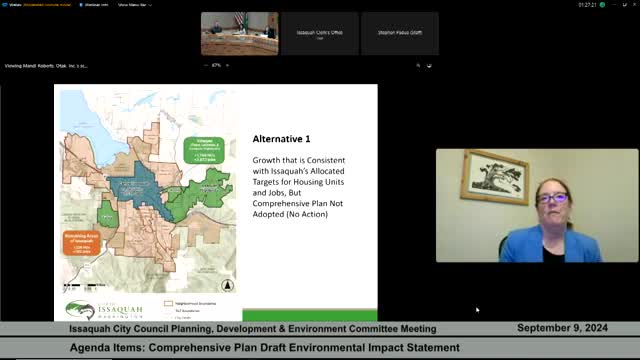City plans aggressive growth strategy to boost jobs and housing
September 09, 2024 | Issaquah, King County, Washington
This article was created by AI summarizing key points discussed. AI makes mistakes, so for full details and context, please refer to the video of the full meeting. Please report any errors so we can fix them. Report an error »

In a recent government meeting, officials discussed various growth alternatives for the city of Issaquah, emphasizing the need for a balanced approach to housing and job development. The analysis presented included three distinct alternatives, each reflecting different levels of growth intensity.
Alternative 1 proposed a slower growth rate, aligning more closely with existing targets. However, concerns were raised by the environmental board regarding the feasibility of a projected population increase of 5,000, suggesting that such growth may not be realistic. This highlighted the necessity for proactive planning to accommodate potential higher growth rates, should they occur.
Alternative 2 focused on increasing housing units and job opportunities, particularly in the central area of Issaquah, which is better equipped with commercial and mixed-use zoning. This approach is expected to support a more robust job market in the region.
The most aggressive option, Alternative 3, aimed for the highest levels of housing and job growth across the city, with a significant concentration in central Issaquah. The analysis indicated that this alternative could lead to greater efficiencies in infrastructure and public services, making it a compelling option for future development.
A critical finding from the draft Environmental Impact Statement (EIS) was that while mitigation measures could prevent significant adverse impacts under all alternatives, Alternative 1 would not align with state and regional policies without the adoption of a comprehensive plan, marking it as a significant concern.
Overall, the discussions underscored the importance of focusing growth in central Issaquah to maximize efficiency in service delivery and infrastructure management, as the city continues to refine its development strategies.
Alternative 1 proposed a slower growth rate, aligning more closely with existing targets. However, concerns were raised by the environmental board regarding the feasibility of a projected population increase of 5,000, suggesting that such growth may not be realistic. This highlighted the necessity for proactive planning to accommodate potential higher growth rates, should they occur.
Alternative 2 focused on increasing housing units and job opportunities, particularly in the central area of Issaquah, which is better equipped with commercial and mixed-use zoning. This approach is expected to support a more robust job market in the region.
The most aggressive option, Alternative 3, aimed for the highest levels of housing and job growth across the city, with a significant concentration in central Issaquah. The analysis indicated that this alternative could lead to greater efficiencies in infrastructure and public services, making it a compelling option for future development.
A critical finding from the draft Environmental Impact Statement (EIS) was that while mitigation measures could prevent significant adverse impacts under all alternatives, Alternative 1 would not align with state and regional policies without the adoption of a comprehensive plan, marking it as a significant concern.
Overall, the discussions underscored the importance of focusing growth in central Issaquah to maximize efficiency in service delivery and infrastructure management, as the city continues to refine its development strategies.
View full meeting
This article is based on a recent meeting—watch the full video and explore the complete transcript for deeper insights into the discussion.
View full meeting
